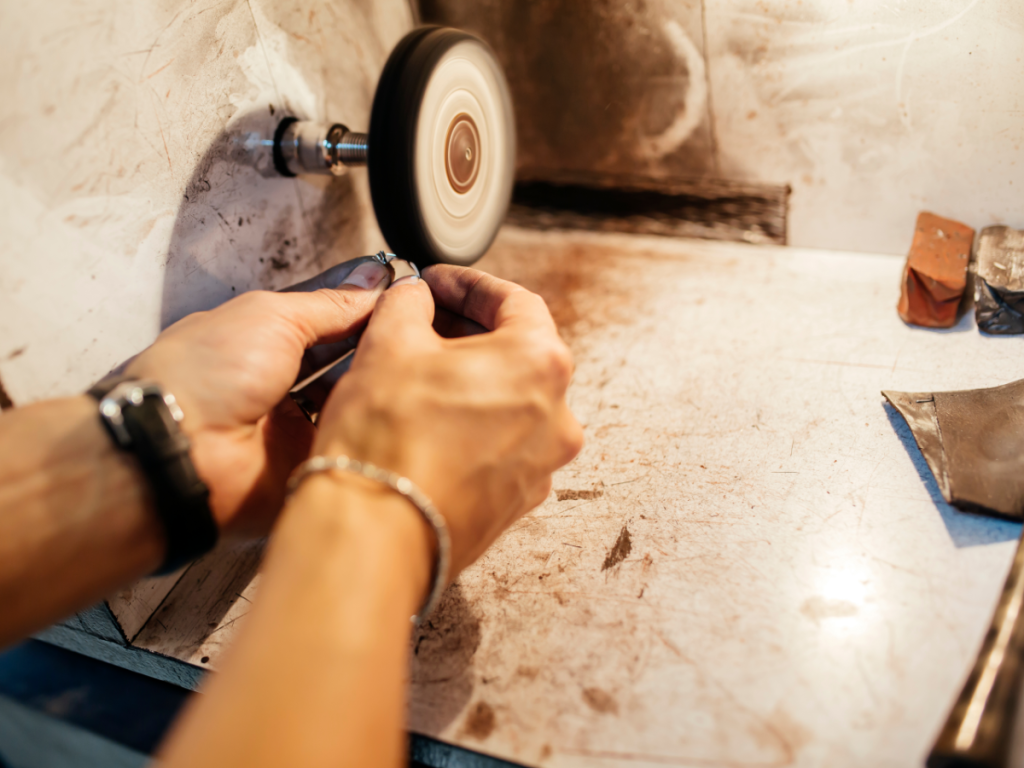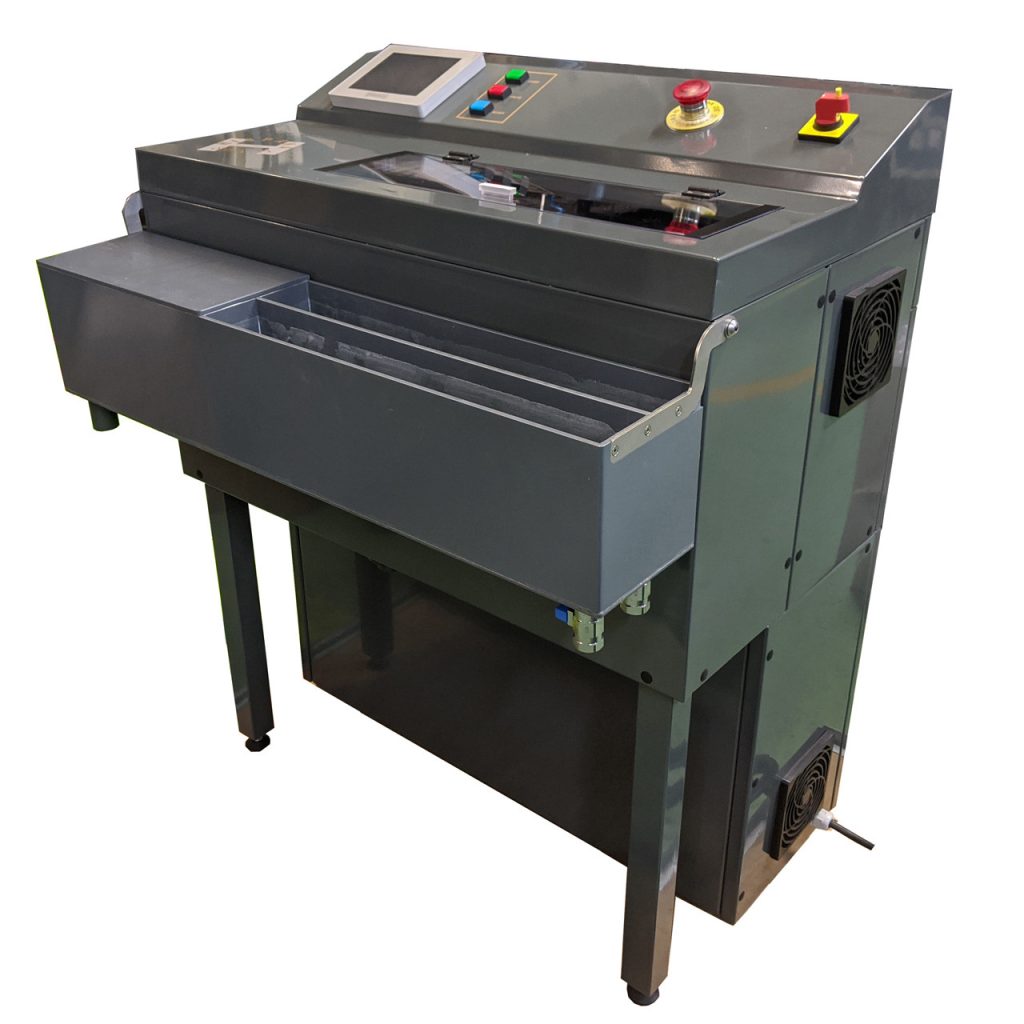Success in jewelry making goes far beyond selecting the finest materials and crafting intricate designs; it hinges on the achieving the right surface finish. This often-overlooked aspect plays a pivotal role in the jewelry industry, where impeccable surfaces are not just an aesthetic choice but a symbol of quality and craftsmanship.
Electropolishing technology enhances jewelry manufacturing by delivering high-quality finishes, reducing manual finishing time, and increasing precious metal recovery. It’s an ideal method for achieving superior surface quality, especially with intricate details and hard-to-reach areas.
Learn About Electropolishing Technology

Electropolishing is an electrochemical process used to remove material from metal surfaces. This process allows you to achieve a high, uniform polish even on difficult to access areas, such as underneath a prong setting.
It’s akin to “electroplating in reverse”, removing the outer layer or “skin” of a metal piece, addressing microscopic imperfections in its finish. The result is a smooth, mirror-like surface finish on jewelry!
Unlike traditional hand polishing, which produces dust and debris and can lead to uneven surfaces, electropolishing refines the finish on jewelry by selectively dissolving the outermost layer of metal, evening out micro-peaks and valleys to remove surface defects.
This precision process is driven by electrochemical principles, with an electrolyte bath and electrical current working in tandem to initiate anodic dissolution (explained further below), polishing while preserving the integrity of complex designs.
Comparing Electropolishing with Other Finishing Techniques
 Modern polishing techniques predominantly fall within one of these categories:
Modern polishing techniques predominantly fall within one of these categories:
- Polishing by Hand: Utilizing rotary tools like a micromotor, flex shaft, or polishing motor, and also employing traditional hand tools.
- Mechanical Tumbling Involves the use of rotary tumblers with steel shot, pins, as well as vibratory tumblers that employ a series of wet and dry media with finer grits to attain the desired polish.
Electropolishing alleviates the shortcomings of traditional polishing methods and effectively addresses their inherent issues described below.
Common Problems with Hand Polishing:
In a production environment, hand polishing presents a significant challenge due to its reliance on skilled labor, a resource that can be scarce and often results in inconsistent outcomes. Individual polishers often favor various buffs and compounds, leading to variations in the finish among pieces completed by different workers, while the risk of over-polishing compounds the issue.
Drawbacks with Mechanical Tumbling:
While mechanical tumbling eliminates the need for strong manual dexterity, a notable drawback is the time it consumes, particularly when working from a fresh casting. This multi-step process can extend up to 8 hours, a significant investment of time. Moreover, complex pieces rich in detail are not well-suited for tumbling, as this method tends to diminish intricate features and compromise sharp edges, potentially causing harm to fine filigree.
Danger! Bombing, an antiquated method using hazardous chemicals like hydrogen peroxide and cyanide for stripping metal surfaces, although historically relevant, poses significant risks. Today, electropolishing provides a far safer and more modern alternative for achieving similar results in metal finishing.
Why Consider Electropolishing for Jewelry?
 If you ask any jeweler what they like doing the most on their piece, how many would say polishing?! Electropolishing technology offers advantages in jewelry manufacturing, making it an appealing method for achieving high-quality surface finishes, especially in hard-to-reach areas, enhancing overall quality of work.
If you ask any jeweler what they like doing the most on their piece, how many would say polishing?! Electropolishing technology offers advantages in jewelry manufacturing, making it an appealing method for achieving high-quality surface finishes, especially in hard-to-reach areas, enhancing overall quality of work.
Precise Material Removal:
This process effectively smooths metal surfaces while maintaining intricate details and preserving the original design and geometry, preventing any rounding or deformation of edges.
Consistent Results:
Electropolishing delivers consistent results across batches, control over the amount of material removed, ensuring uniformity in surface finish, and quality for each piece of jewelry produced. This level of consistency is crucial when it comes to upholding brand reputation and meeting customer expectations.
Reduced Manual Labor and Handling:
Electropolishing automates the finishing process, enhancing efficiency, minimizing human errors and eliminating variations among polishers. This method doesn’t replace workers, but enables these jewelers to transition to specialized manufacturing roles.
Cost-Effectiveness:
By incorporating electropolishing into your manufacturing process, you will decrease the amount of time spent and metal removed during hand finishing, decreasing overall productions costs.
Precious Metal Recovery:
Since metal removed from the surface is collected on the cathode during electropolishing, precious metal recovery is simplified! The cathode collects pure metal, which is a big advantage when compared to what is inside your dust collector bag when metal particles mix in with the debris from abrasives and polishing compounds.
Environmentally Friendly:
Electropolishing is considered environmentally friendly compared to some other finishing processes. It typically uses fewer chemicals and produces less waste, contributing to a more sustainable manufacturing approach.
The Electropolishing Process in Detail
- Preparation: The piece is cleaned to ensure a dirt-free surface for the electropolishing process.
- Immersion: The workpiece is immersed in an electrolyte solution. The electrolyte acts as a conductor for the electric current.
- Electric Current Application: A direct current (DC) electrical current is passed through the workpiece, with the metal workpiece being the anode (positive electrode). A cathode (negative electrode) is also present in the electrolyte bath, collecting the metal removed.
- Material Removal: As the electric current flows through the metal, it causes selective removal of material from the surface, leveling out any irregularities and smoothing the surface.
- Anode Dissolution*: Metal ions are released from the anode (workpiece) and dissolve into the electrolyte. This is what results in the removal of material from the surface.
- Surface Smoothing: The electropolishing process smooths the surface, removing microburrs, pits, and other imperfections, leaving a polished and shiny surface finish.
*In anodic dissolution, an electrode is immersed in a solution containing a supporting electrolyte and the organic linker. When an oxidation voltage or current is applied, the electrode (anode) dissolves and consequently, the metal ions are rapidly released near the electrode surface. Reference Science Direct
Explore Hispana’s Electropolishing Machines
Electropolishing technology is an opportunity to embrace modern techniques that will enhance craftsmanship and give you a competitive edge. Time is money in any sized manufacturing environment, and electropolishing is a terrific solution that streamlines the finishing process and cuts down on the typical handwork time required in jewelry production.
Considering adding Electropolishing equipment to your shop?
Our Hispana machines process yellow gold, white gold, and red gold in 8 to 22 karats, as well as silver and brass. Hispana’s proprietary solutions ensure a uniform finish without altering your design, even on pieces with stones and enamels. They also feature a user-friendly controller and are proudly made in Spain.
Read more about machine we carry in this section, and please contact us with questions. We are happy to accommodate samples requests as well.
View Gesswein’s Electropolishing Machines
Comparing First Step to Second Step Electropolishing Machines
Hispana offers two types of machines for electropolishing, first and second step finishing.
When considering 1st step machines, envision precise material removal and selective grinding from the outer surface. These machines employ larger media that primarily targets the exterior layer.
In contrast, 2nd step machines utilize brushes and fine resin particles to intricately polish both inner and smaller areas, without harming fine details.

First Step Processing Equipment
Hispana GP-G10 1st Step Electro Polisher for Gold
The GP-G10 is designed for high-capacity production of white, red, and yellow gold jewelry ranging from 9 to 18 karats.
This model, as well as the GP-G10S below, process up to 66 pieces taking between one to two hours depending on the size, density, and complexity of those pieces.
Hispana GP-G10S 1st Step Electro Polisher for Silver
The GP-G10S, a 1st step electropolisher designed for silver, boasts high production capacity, processing up to 66 pieces in one to two hours.
Hispana PMG-130 1st Step Silver Electro Polisher
The PMG, a 1st step electropolishing machine for silver, can simultaneously process up to 129 pieces in less than 40 minutes, achieving a uniform external polish essential for cast pieces, featuring a straightforward manual control panel for user-friendly operation and automation capabilities.

Second Step Processing Equipment
These models are based on the 2nd Step Energy system which uses small particles (up to 0.3mm in diameter) as a catalyst for the chemical process as well as a proprietary solution and brush technology (6 brushes). This process allows you to achieve a high, uniform polish even on difficult to access interiors.
Hispana EN-34 2nd Step Electro Polisher for Gold The EN-34 model caters to jewelry companies with small-scale production needs, delivering high-quality finishes while simultaneously processing 9 to 21 pieces in one to two hours, depending on their density.
Hispana EN-44 2nd Step Electro Polisher for Gold The EN-44 is ideal for medium production capacity, handling gold jewelry from 9 to 22 karat with processing times of 60-90 minutes for up to 66 pieces, depending on their size and complexity.
Hispana EN-442-6 2nd Step Electro Polisher The EN-442-6 features two baths, and is designed to efficiently handle a substantial production capacity of white, red, and yellow gold jewelry ranging from 9 to 22 karats, processing up to 66 pieces in one to two hours depending on their size, density, and complexity.
Hispana SP211 2nd Step Electro Polisher for Silver The SP-211 is a 2nd step electropolisher tailored for medium to large silver jewelry producers seeking high-quality finishes, with the capacity to process up to 66 pieces in one to two hours.




